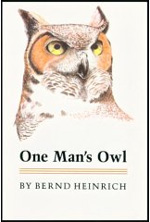Review of "One Man's Owl"

Author(s): Bernd Heinrich
Published: December 13, 1993, Princeton University Press, ISBN: 0691000654
 by James A. Huggins, Ph.D., University Professor & Director of the Hammons Center for Scientific Studies
by James A. Huggins, Ph.D., University Professor & Director of the Hammons Center for Scientific Studies
April 92, 2008 -
This is the second of Heinrich’s books that I have highlighted on this website and if you have decided that I must be a fan you would be close to correct. As I have stated in the past I find his ability to write, to explain his approach to the vicissitudes of nature and to transmit his love for nature very compelling. I have always enjoyed a good digest of the natural world and Heinrich is a master at communication. This relaxed book represents a nearly three year journey the author shared with a great horned owl that he aptly named Bubo (taken from the genus name for the species). This is, from my own experience as a biologist and wildlife rehabilitator specializing in raptors, a remarkable glimpse into the psyche of one of the fiercest and most capable avian predators on the continent. I was not the least bit surprised that the owl, taken from the wild as a “brancher”, imprinted upon the source of his culinary comfort; nor was I taken aback at the lack of fear that was shown when things did not go his way. Great horns are a superlative species with enormous power in the talons they so quickly wield. I shall never forget the first time that I put a belligerent great horned owl on my fist. My mentor told me that I was the first to have done so with this particular owl on their initial attempt. As I think back to the difficulty of that encounter I suspect I was simply more determined than the owl on that exacting day.
Through the course of this book the author describes an owl in the house (perish the thought for most readers), attack cues that emerged from studying his behavior, interspecific interactions with creatures that range from crows and jays to cats, the trials and tribulations of learning to hunt without parental example, territorial defense and even the companionship shared by man and beast. I was particularly interested in the time that this owl spent in the rehabilitation center and not at all amazed that the bird was found simply to be untenable as a prospect for a return to the wild. I am certain he would have made a very good education bird for some facility somewhere but the story does have a much happier ending. Heinrich is allowed, and this is quite remarkable, to take the bird back to his Maine camp and proceed with the “conditioning” that would allow Bubo to gradually “wean” himself from human dependence and reinter the world and the niche for which God designed him. It is always a happy ending for the rehab person who puts one back into the wild…even for an old academic like myself.
Heinrich was particularly interested in the why and wherefores of mobbing behavior and he has offered some very good insights into the behavior. I was also very pleased that he included a bibliography for the reader that wished to pursue more advanced points of the life of the great horned owl and , just by chance, those that had not been so influenced by human interaction. By Heinrich’s own admission this was never meant to be a scientific treatise and it clearly is not; however, the book is an easy and enlightening nature read penned by a naturalist that did catch some of the finer points of an owl that had little choice but to exist within the confines of human construct. I loved Heinrich’s description of Bubo as a sometimes clown and sometimes terrorist (I have taken some liberty with the wording) for such is the inevitable conclusion, at least from a human perspective, when such interspecific interactions are contrived or forced upon two very different species. How “odd” Bubo must have thought, if indeed these creatures can muster such an anthropomorphic neural cognition, this human that occupied so much of his life.
In addition, to learning a great deal about the bird there can be considerable insight gained about the mind of the naturalist in this jaunt through one man’s summers. The aspiring naturalist would do well to pay attention to what makes this man tick and to what drives the lust within our hearts to probe the depths of the unknown in the world that we have been given. For a short time the author opens a window to his soul and I learned much about the man himself. I felt genuine sorrow when he suffered greater loss of relationship than was encompassed by the owl. Such relationships, owl and otherwise, are the incidents that mark our lives as profoundly unique. It is my great desire that Heinrich and all who share his love for nature will look beyond the physical world and into the spiritual realm that designed both man and Bubo virginianus for the niches we are assigned in this life. May owl and man find peace as they live out the interspecific and intraspecific relationships that so aptly define life on this planet! I highly recommend you read One Man’s Owl.

